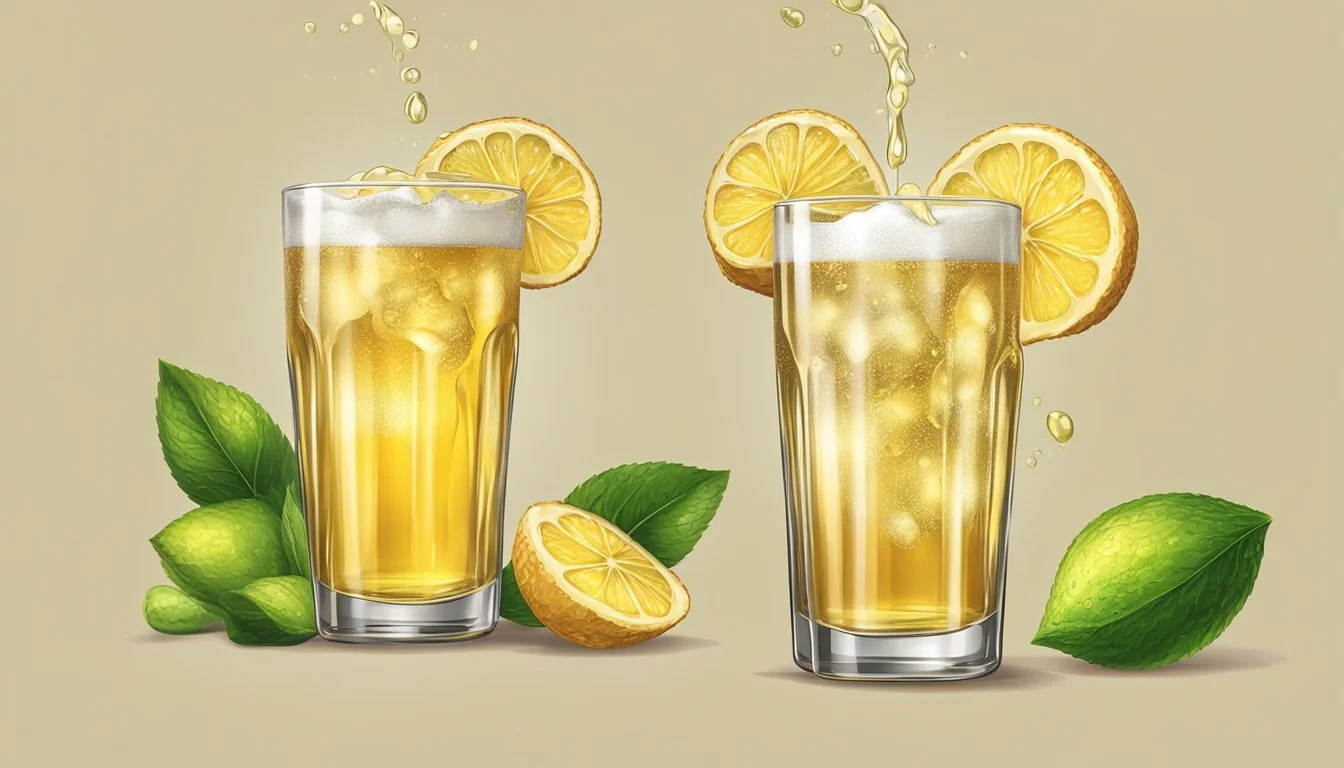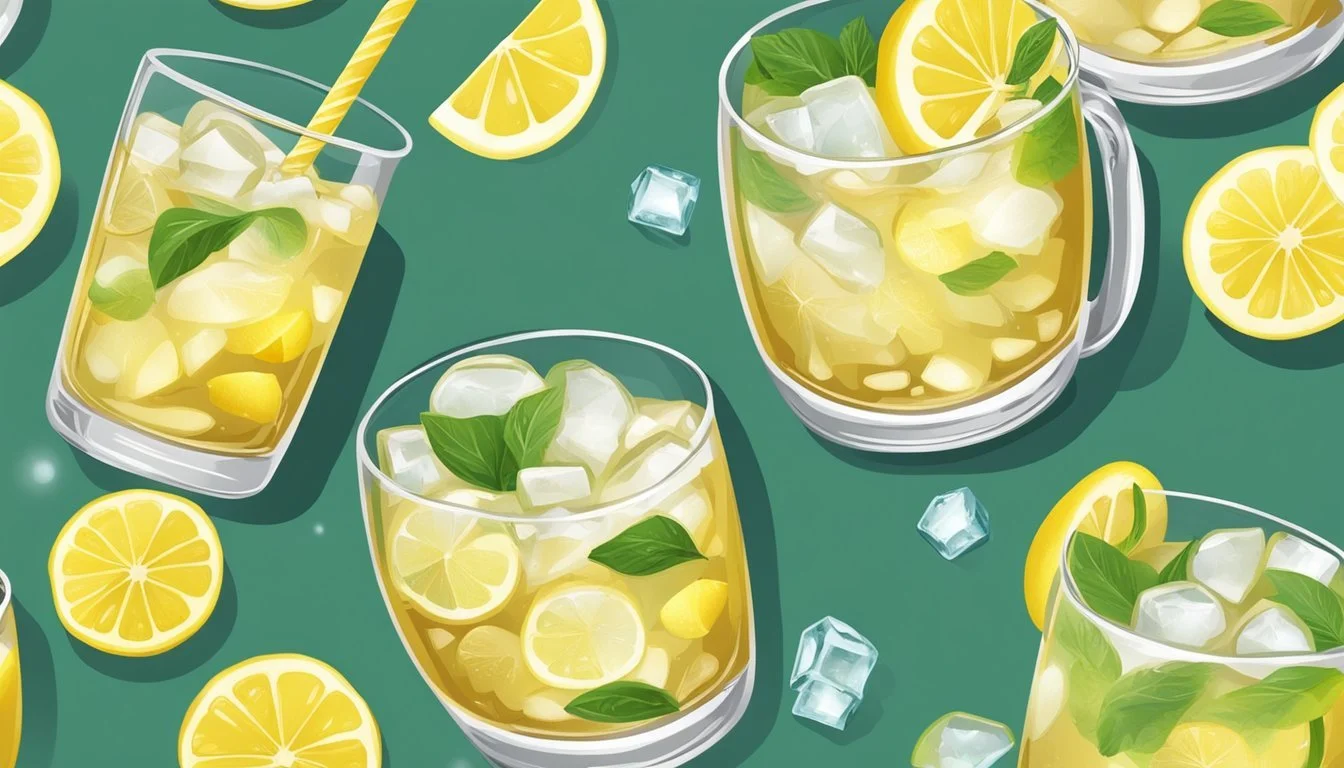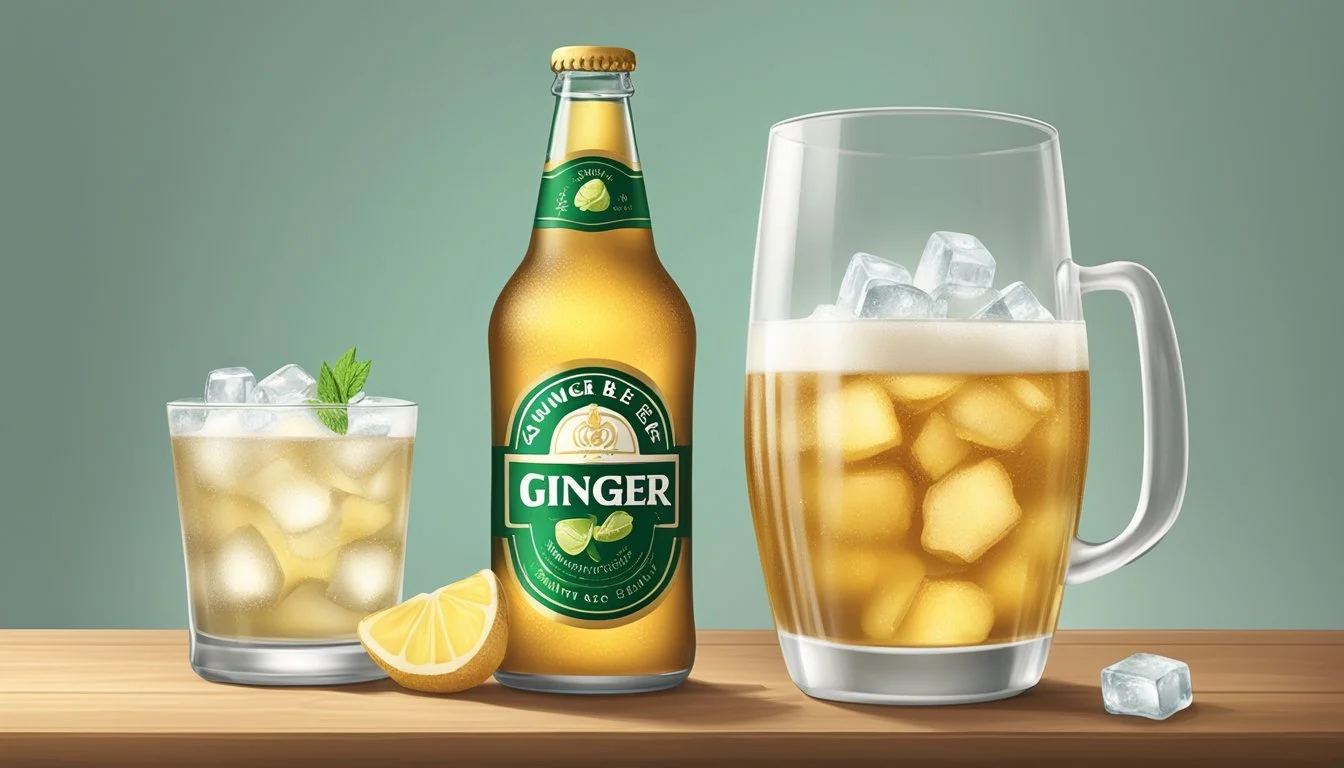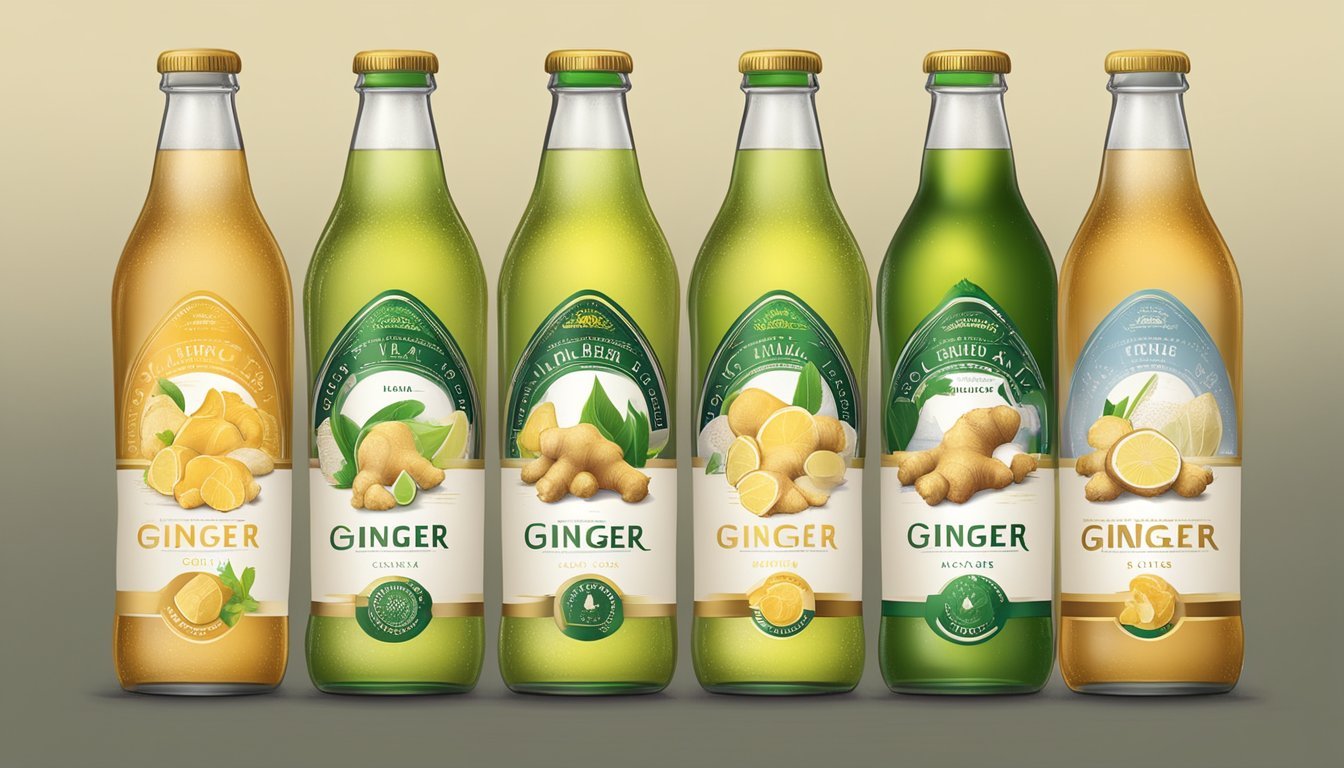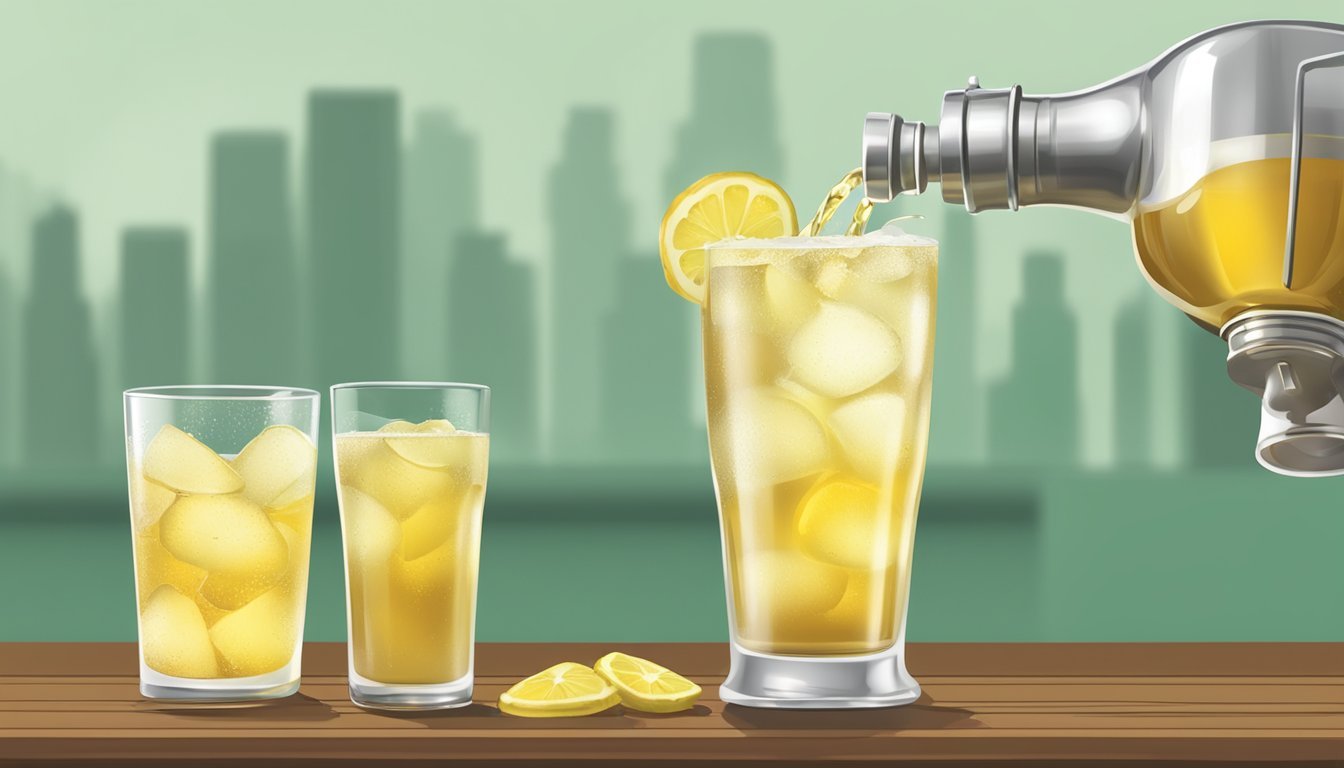How to Substitute Ginger Ale for Ginger Beer
Quick Swap Guide
Ginger beer is often celebrated for its robust flavor and spicy kick, characteristics that make it a favorite in many cocktail recipes and culinary applications. Its unique taste, derived from the ginger root, has distinguished it as an irreplaceable component in drinks like the Moscow Mule and Dark and Stormy. However, ginger ale, a more commonly found and milder carbonated beverage, is frequently used as an alternative when ginger beer is unavailable.
When substituting ginger ale for ginger beer, one should consider the latter’s more pronounced ginger taste and lesser sweetness. Ginger ale, by contrast, while still flavored with ginger, tends to be lighter with a more subdued ginger flavor and a higher sweetness level. This makes it a suitable stand-in for non-alcoholic beverages and can complement cocktails, albeit with a slightly different flavor profile.
Adapting recipes to incorporate ginger ale in place of ginger beer may require adjustments to balance sweetness and intensify the ginger note. This could involve the addition of fresh ginger or ginger extract to reinforce the desired piquancy. Therefore, while ginger ale can serve as a substitute for ginger beer, it should be done with an understanding of the flavor nuances between the two beverages.
Understanding Ginger Beer and Ginger Ale
To adequately substitute ginger ale for ginger beer, it's crucial to grasp their distinct properties and production methods. These drinks differ in taste, brewing technique, and historical background, which influence their applications in beverages and recipes.
Origins and History
Ginger beer originated in England in the mid-18th century. It became a popular drink in the Caribbean, where it was traditionally brewed as an alcoholic beverage using fermentation processes similar to beer. Meanwhile, ginger ale is believed to have been first created in Ireland but became widely popular in Canada, with Canada Dry being a leading brand since the 1900s. Unlike ginger beer, ginger ale was developed as a non-alcoholic, carbonated soft drink.
Defining Characteristics
Ginger beer typically features a strong, spicy flavor due to its brewed nature, with certain varieties containing alcohol though most commercial brands are non-alcoholic. It's made by fermenting ginger spice, yeast, and sugar. In contrast, ginger ale is a milder, sweeter carbonated soft drink. It is not brewed or fermented but rather made by adding ginger flavor to carbonated water, which results in a less intense ginger taste.
Feature Ginger Beer Ginger Ale Flavor Bold & spicy Mild & sweet Fermentation Typically yes No Alcohol Content Varies; often non-alcoholic Non-alcoholic Carbonation Natural from fermentation Added artificially
Commercial Production
Modern commercial production of ginger beer involves either traditional fermentation with yeast, like champagne yeast, or carbonation methods to create the beverage, with most brands offering non-alcoholic versions. On the other hand, commercial production of ginger ale doesn't require fermentation; it involves adding ginger flavors to carbonated water. Major brands like Canada Dry or Schweppes produce ginger ale with consistent sweetness and carbonation levels, making it a widespread soft drink choice internationally.
Culinary Uses of Ginger Beverages
Ginger beverages, notably ginger ale and ginger beer, bring a balance of sweetness, spice, and carbonation to a variety of culinary applications, ranging from cocktails to cooking and baking.
Cocktail Recipes
A classic Moscow Mule combines ginger beer with vodka and a squeeze of lime, served over ice. To substitute ginger ale:
Moscow Mule: Use ginger ale in place of ginger beer and add a little extra lime to compensate for the milder ginger flavor.
Dark and Stormy cocktails require a bold ginger beer to contrast with dark rum, but ginger ale can be used if it's infused with extra citrus:
Dark and Stormy: Mix ginger ale with dark rum, and add a generous amount of fresh lime to bolster the citrus notes.
For a Pimm’s Cup, ginger beer adds a spicy edge, but ginger ale will maintain the desired sweetness while keeping the drink refreshing:
Pimm’s Cup: Substitute ginger ale for ginger beer and integrate slices of lemon and lime to enhance the fruitiness.
Cooking and Baking
In cooking, ginger ale can be an effective substitute for ginger beer in marinades and dressings, imparting a subtle ginger flavor with a touch of sweetness. For example:
Marinade for Chicken or Pork: Replace ginger beer with ginger ale and include additional herbs or spices, such as thyme or minced garlic, to amplify the depth of flavors.
In baking, the effervescence of ginger ale can help create light doughs and batters, presenting a milder ginger taste compared to ginger beer:
Baking Bread or Cakes: Use an equal amount of ginger ale in place of ginger beer. If the recipe is spice-forward, consider including a pinch more ground ginger to make up for the milder profile of ginger ale.
Substituting Ginger Ale for Ginger Beer
When substituting ginger ale for ginger beer, one must consider the differences in taste, alcohol content, and how it interacts with other ingredients. Ginger ale offers a milder ginger flavor with a fizzy carbonation, making it suitable for those who prefer a less intense taste.
Taste and Flavor Considerations
Ginger beer and ginger ale differ significantly in their flavor profiles. Ginger beer, created through a fermentation process, typically has a spicier and more pronounced ginger flavor. On the other hand, ginger ale is a carbonated soft drink that provides a milder, sweeter, and often more citrusy flavor compared to its beer counterpart. When substituting ginger ale in recipes or beverages that call for ginger beer, it's essential to adjust for the milder flavor. Consider:
Adding a pinch of ground ginger to enhance the spice.
Including a small amount of fresh lime juice to intensify the citrus notes if needed.
Adjusting Alcohol Content
Ginger beer can be alcoholic or non-alcoholic, but it's often found as a non-alcoholic beverage with a zesty kick. When using ginger ale as a substitute, which is generally non-alcoholic, one doesn't usually need to adjust the alcohol content in recipes. However, if a recipe requires an alcoholic ginger beer, adding a splash of a spirit or liqueur can introduce the desired kick. Options include:
A shot of vodka for neutral alcohol addition.
A touch of ginger liqueur to keep the ginger profile prominent.
Mixing with Other Ingredients
The carbonation level in ginger ale is typically higher than that of ginger beer, making ginger ale the fizzier choice. This increased fizz can affect the texture of cocktails and the overall drinking experience. When replacing ginger beer with ginger ale in mixed drinks such as Moscow Mules or Dark and Stormys, consider compensating for the beverage’s mildness with stronger flavor enhancers:
Simple syrup can be reduced to balance the extra sweetness from ginger ale.
Lime juice or lemon-lime soda can contribute a more assertive citrus flavor to mimic the tangy profile of ginger beer.
Garnishes like a slice of fresh ginger or a sprig of mint can add aromatic qualities.
In summary, ginger ale can be a convenient substitute for ginger beer with a few adjustments for taste, alcohol content, and interaction with other mixers.
DIY Ginger Beverage Recipes
Creating DIY ginger beverages offers an exciting foray into the world of homemade drinks. Whether looking for a robust ginger beer to brew at home or a quick ginger ale alternative, these recipes cater to various preferences and skill levels.
Homemade Ginger Beer Preparation
Ingredients:
1/4 lb fresh ginger, grated
1 cup sugar
8 cups water
Juice of 2 lemons
1/2 teaspoon cream of tartar (optional for added tanginess)
1 teaspoon baker's yeast (or a ginger bug starter)
Instructions:
Prepare the ginger: Grate the fresh ginger using a fine grater until you have approximately 3.5 tablespoons.
Make the syrup: Combine the sugar, grated ginger, and 4 cups of water in a saucepan. Heat until the sugar dissolves, then turn off the heat and allow the mixture to steep.
Add lemon juice and cream of tartar: After steeping, strain the ginger syrup and add the lemon juice and cream of tartar to the liquid.
Cool: Let the mixture cool to room temperature.
Activate the yeast: In a separate small bowl, mix yeast with a little warm water and let it sit for a few minutes.
Combine and ferment: Add the activated yeast to the ginger syrup, along with the remaining 4 cups of water. Transfer to a fermenting vessel and cover with a breathable cloth.
Ferment: Let the mixture ferment in a warm, dark place for 3 to 5 days, stirring daily.
Bottle and carbonate: Once fermented, bottle the ginger beer in clean soda bottles, leaving some space at the top. Seal and allow it to carbonate for another 2-3 days before refrigerating.
Alternative Ginger Ale Mixes
For a swift substitute to ginger ale that captures similar zest, try these alternative mixes:
Ginger Ale Substitute #1 - Sparkling Ginger Water
Mix 1/2 teaspoon of ginger extract with 8 ounces of sparkling water. Sweeten with honey or simple syrup to taste.
Ginger Ale Substitute #2 - The Shirley Temple Remix
Combine 1 ounce of grenadine with 8 ounces of club soda. Add a dash of ginger syrup or ginger juice for a gingery spin on this classic.
Ginger Ale Substitute #3 - Ginger Kombucha Twist
If you're familiar with kombucha brewing, infuse your next batch with extra ginger. A SCOBY (symbiotic culture of bacteria and yeast) ferments the tea and sugar mixture, imparted with fresh ginger to create a ginger kombucha that makes a refreshing stand-in for ginger ale.
Health and Dietary Information
When substituting ginger ale for ginger beer, it is important for individuals to consider the health and dietary implications, such as calorie content and possible digestive benefits.
Nutritional Differences
Ginger ale is generally a carbonated soft drink that is flavored with ginger. It is often sweeter and contains added sugars, which contribute to its higher calorie count. On the other hand, ginger beer is a fermented drink with a robust ginger flavor. Though it is labeled as a beer, most commercially available ginger beers are non-alcoholic beverages. They may contain alcohol in very minute quantities, typically below 0.5%, due to the natural fermentation process involving bacteria. However, some varieties contain higher alcohol levels and are labeled accordingly.
Nutritional content per 12 oz (355 ml) serving:
Nutrient Ginger Ale Ginger Beer Calories 124 170 Total Sugars 32g 40g
Figures are approximate and can vary by brand and recipe.
Gastrointestinal Benefits
Both beverages offer different digestive advantages. Ginger itself is known for its ability to soothe an upset stomach and aid in digestion. Ginger ale, being less concentrated in ginger content, may provide mild gastrointestinal relief. In contrast, the higher ginger concentration in ginger beer can offer more significant digestive benefits, potentially aiding with nausea and upset stomach. It is important to note that for individuals with sensitive stomachs, the higher sugar and calorie content in ginger beer might negate these benefits if consumed in large quantities.
Cultural and Regional Variations
When substituting ginger ale for ginger beer, understanding the cultural and regional variations can greatly inform the choice of substitute. The ginger intensity and sweetness levels vary, largely influenced by production methods and regional taste preferences.
Global Ginger Beer Styles
Caribbean Ginger Beer: In the Caribbean, ginger beer often has a strong, spicy kick, resulting from the generous use of fresh ginger. It may also include other ingredients like lime, which impart a unique regional flavor. The traditional Caribbean version is sometimes fermented with a ginger beer plant which lends it a slightly effervescent quality.
UK Ginger Beer: British-style ginger beer tends to be cloudy and have a more robust flavor. The fermentation process imparts a slight fizz. It is usually less sweet than its American counterparts.
Australian Ginger Beer: Australian ginger beer is generally sweet and mild compared to the Caribbean and British types. Some brands offer an alcoholic version, which has a higher alcohol content than the typical ginger beer.
Popular Ginger Ale Brands
Canada Dry: One of the most recognized brands in North America, Canada Dry ginger ale has a mild ginger flavor and is quite sweet. Its ubiquity makes it a common choice for substitution.
Schweppes: Another widely available brand, Schweppes ginger ale tends to have a sharper ginger taste compared to Canada Dry but is still on the milder side relative to ginger beers.
Here is a comparison of these brands highlighting their distinctive qualities:
Brand Country of Origin Ginger Intensity Sweetness Level Notable Characteristics Canada Dry Canada Mild High Smooth, sweet, widely available Schweppes United Kingdom Moderate Medium Sharper ginger flavor
Note: The table represents general characteristics and may vary slightly by region or specific product formulation.
Practical Tips and Tricks
When substituting ginger ale for ginger beer in any application, it is important to consider both the storage of your ingredients to maintain their quality and how best to serve them to ensure an enjoyable experience.
Storage and Shelf Life
Ginger Ale:
Storage: To preserve the bright effervescence of ginger ale, it should be stored in a cool, dark place away from direct sunlight. Once opened, refrigeration is crucial to keep it carbonated.
Shelf Life: An unopened bottle of ginger ale can last up to 9 months if stored correctly. After opening, it should be consumed within 1-2 days for the best carbonation levels.
Ginger Beer:
Storage: Similar to ginger ale, ginger beer should be stored away from light and heat. Refrigeration after opening can help maintain its unique properties.
Shelf Life: An unopened ginger beer has a similar shelf life to ginger ale, but since it may contain live cultures from the fermentation process, its flavor profile might change over time.
Serving Suggestions
Mixer for Cocktails: Replace ginger beer with ginger ale in cocktails such as Moscow Mules or Dark and Stormys. Ginger ale tends to be less spicy, so one might add a small pinch of grated ginger to mimic the ginger beer's kick if desired.
Moscow Mule: Serve the Moscow Mule in a copper mug to keep the drink cold, adding a classic presentation touch. Use ginger ale as a straightforward replacement for ginger beer, and garnish with a lime wedge or wheel.
Garnish: To accentuate the citrus notes when using ginger ale, one can add extra citrus garnish to the drink. Lemon or lime wheels add visual appeal and a tangy zest that complements the sweetness of ginger ale.
Non-Alcoholic Beverages: Ginger ale, due to its sweetness, can be enjoyed by itself over ice or with a squeeze of fresh lime or lemon for an easy non-alcoholic refreshment that retains an effervescent charm.
Evaluating Commercial and Artisan Brands
When substituting ginger ale for ginger beer, the consumer must consider the product's characteristics, which varies among commercial and artisan brands. Differences in sugar content, carbonation levels, flavor profile, and occasionally alcohol content impact their suitability as substitutes.
Reading and Understanding Labels
Labels provide essential information on the ingredients, nutritional content, and the process used to create the carbonated beverage. With ginger beer, one should check for indicators of brewing or fermentation, as this affects the flavor intensity and may introduce a minimal alcohol content. Ginger ale labels typically highlight carbonation and flavor sources, such as real ginger extract or artificial flavors. Sugar content is another critical aspect, observable through grams per serving. Natural and artisan brands might use alternative sweeteners like honey, which can influence the final taste of the drink.
Check for:
Carbonation method: naturally fermented or artificially carbonated
Flavor source: real ginger or flavor additives
Sweeteners used: cane sugar, high-fructose corn syrup, honey
Additional ingredients: preservatives or natural extracts
Alcohol presence: 0.5% or less, for fermented types
Brand Comparisons
Comparing brands involves a direct examination of how closely a ginger ale can mimic the robust depth found in ginger beer. Commercial ginger ale brands tend to be lighter, with a subtler ginger flavor and higher carbonation. They are often sweetened more than ginger beer and can include various types of sugar including high-fructose corn syrup. In contrast, artisan or craft ginger beers offer a strong, spicy ginger kick and deeper flavors, due to traditional brewing methods and the inclusion of ingredients like lemon or cane sugar.
Comparison table for a non-alcoholic beverage substitution:
Aspect Commercial Ginger Ale Artisan Ginger Beer Carbonation High, artificially carbonated Moderate, naturally fermented Ginger Flavor Mild, sometimes artificial Bold, usually natural Sweetness Often high Varies, generally lower Ingredients More additives and preservatives Fewer, simpler ingredients Alcohol Content None Minimal, up to 0.5% if fermented
With the nuances among brands understood, one can choose a ginger ale that most closely aligns with the desired features of ginger beer.

